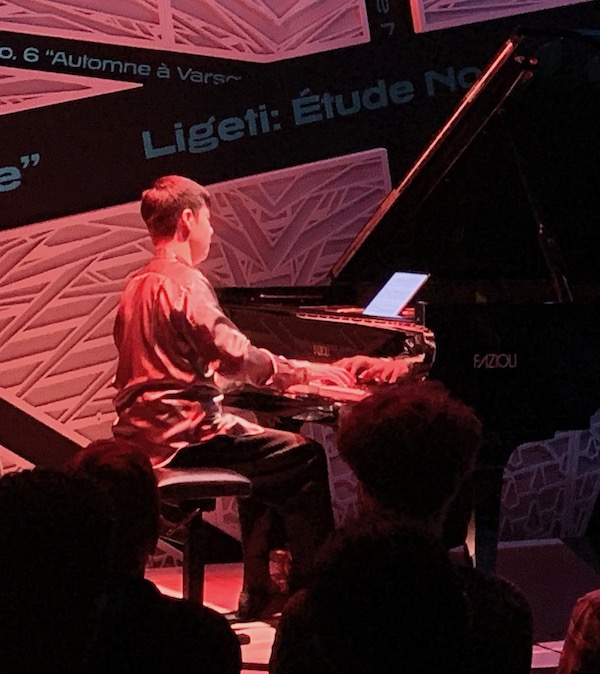Han Chen’s remarkable playing equal to the genius of Ligeti’s Etudes

György Ligeti’s three books of Études for piano are among the greatest works of their kind in the classical repertoire, and arguably the last transformational work that the classical world has seen since the end of the 20th century. They share equal stature with the Études of Chopin and Debussy, works that are brilliant explorations of what can be done with the the most skillful piano technique. Ligeti’s are also imaginative, inventive, and expressive—a challenge for the pianist and a pleasure to the listener.
The great breakthrough of Ligeti’s Études are that they renew the 19th century tradition of Chopin and Schumann with ideas synthesized from the polyrhythms of African music, the mind-boggling player-piano canons of Conlon Nancarrow, and the playing of the great boogie-woogie, stride, and jazz piano masters like Thelonious Monk. They demand virtuosic levels of technique and energy just for the notes, and to really play them one needs to thrive on Ligeti’s musical personality, which is a combination of dreamy, serious, witty, and slapstick, often simultaneously. Sunday night, the young Taiwanese pianist Han Chen tackled all three books—and much more—at National Sawdust. His performance was incredible.
The Études alone made for a significant concert, but this was an event, titled “Infinite Staircase,” a connection to Étude No. 13, “L’escalier du diable.” Co-commissioned by Chen and the Metropolis Ensemble, Ligeti’s music was paired with short pieces from eighteen different composers—all world premiers—that were inspired by individual etudes. Chen didn’t set all these in compositional order or directly matched pairs, instead he grouped several Études and new works together in blocks that shared roughly similar techniques or moods, and shaped the energy of the overall program so that it ramped quickly to a sustained plateau, then explored more relaxed territory, before finishing with another long burst of energy.
Ligeti wasn’t first. The evening began with Vivian Fung’s “White on Black.” Its combination of bird calls and music that sounded like slowly falling leaves was one of the finest of the new works, refined and full of personality. Fung interpolated bits of Ligeti but it was clearly in her own voice. As it turned out, in terms of the new music it was also an outlier.
Beyond the compositional genius of the Études—Ligeti used some of the simplest ideas possible to create incredibly complex music—what makes the work masterful is that there is so much personality in the music, it is a clearly defined individual voice that goes beyond the technical into the charismatic, the personal. As with Chopin, in this music we hear what Ligeti found fun, fascinating, and beautiful.
The new pieces, on the other hand, were mostly dutiful. They had their own technical challenges, calling for speed and articulation, but almost nothing beyond—muscular but generic, like brutalist architecture. There were few personal touches, few instances of a clear individual voice, of an aesthetic viewpoint with any real idiosyncrasies. Meng Wang’s subtle piece had Chen simultaneously playing the keys and plucking the interior strings, a delicate ringing sound that seemed to have a question mark at the end, as if the composer was interested in something unpredictable. Jessie Cox’s work was also memorable, reaching back to Ives with a sense of surprise and quirkiness.
A couple were simply poor, derivative and incoherent, while the rest came and went as placeholders for Chen’s next thrilling run through Ligeti. And here he was astonishing, with some of the finest pianism one has ever witnessed. Beyond sheer dexterity, this was tremendously musical playing, with every phrase clear and pointed in a certain direction, fluid control of dynamics and form, a combination of articulation and force that was hard to believe. One had the feeling that Chen was deep inside the work, opening up every detail of Ligeti’s musical personality.
His energy and stamina within each Étude and through the whole concert were extraordinary. Dense, fast ones like No. 6, “Galamb Borong,” and No. 14, “Coloana Infinita” were driving, building up excitement and a feeling of mass, and slow, impressionist ones like No. 5, “Arc-en-ciel,” and No. 15, “White on White,” had delicate, spacious surfaces and a sensation of great weight underneath. Fundamental to all this was rhythm. Ligeti’s rhythms go far beyond the norms of the classical tradition—something few of the other composers seemed to have heard—mixing multiple pulses and dance-like accents into music that truly swings, and Chen’s playing of things like No. 4, “Fanfares,” was body-rocking.
All of this was in one continuous, two-hour performance—Chen’s focus and energy were high for the duration, a feat in and of itself. Between each block of pieces there was a brief pause with electronic ambient music from Phong Tran, which gave Chen a chance to catch his breath and the piano, and for the audience to catch theirs. This was the kind of gripping playing that had one leaning forward, tensing involuntarily, all sensations driven by what was flying off of Chen’s hands and out of the piano.
This was accompanied by the inconsistent and seemingly random appearance of some simplistic lighting design, with a few flashes, some swirling patterns, a small red spotlight panning across Chen and the piano. The visuals were arbitrary, aimless, and distracting— if it’s possible for lights to lack all conviction, these did.
Chen’s playing obliterated all secondary considerations and experiences though, and probably ruined the listener for any other experience of this music.